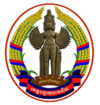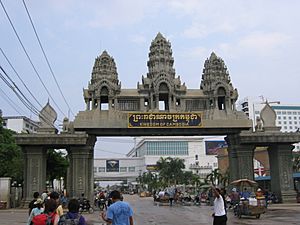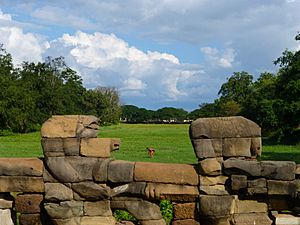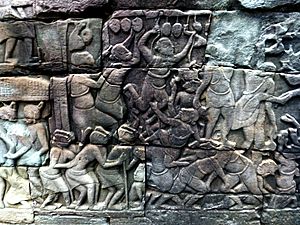Banteay Meanchey province facts for kids
Quick facts for kids
Banteay Meanchey
បន្ទាយមានជ័យ
|
||
|---|---|---|
| Banteay Meanchey Province ខេត្តបន្ទាយមានជ័យ |
||
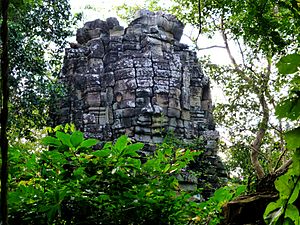
Banteay Chhmar Temple
|
||
|
||
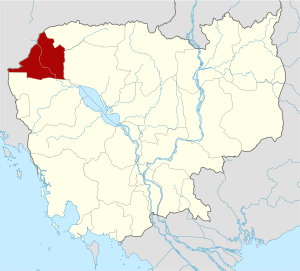
Map of Cambodia highlighting Banteay Meanchey
|
||
| Country | ||
| Provincial status | 1993 | |
| Capital | Serei Saophoan | |
| Subdivisions | 2 municipalities; 7 districts | |
| Area | ||
| • Total | 6,679 km2 (2,579 sq mi) | |
| Area rank | 12th | |
| Population
(2019 census)
|
||
| • Total | ||
| • Rank | 9th | |
| • Density | 129/km2 (330/sq mi) | |
| • Density rank | 9th | |
| Time zone | UTC+07:00 (ICT) | |
| Dialing code | +855 | |
| ISO 3166 code | KH-1 | |
Banteay Meanchey (Khmer: បន្ទាយមានជ័យ) is a province in the far northwest of Cambodia. It shares borders with Oddar Meanchey to the north, Siem Reap to the east, and Battambang to the south. To the west, it has an international border with Thailand. The capital and largest city of the province is Serei Saophoan.
Banteay Meanchey is the 13th largest province in Cambodia. It has a population of 861,883 people, making it the ninth most populated province. The city of Poipet, located in the western part of the province, is an important border crossing point into Thailand. Banteay Meanchey is also one of the nine provinces that are part of the Tonlé Sap Biosphere Reserve, a special area for nature.
Contents
What Does Banteay Meanchey Mean?
The name Banteay Meanchey means "Victorious Fortress" in the Khmer language. The word chey (ជ័យ) comes from the Sanskrit word jaya, which means "victory." The word mean (មាន) means "to have." So, "mean chey" means "to have victory." Finally, banteay (បន្ទាយ) is a Khmer word for "fortress" or "castle."
A Look at Banteay Meanchey's Past
This area was once part of the huge Khmer Empire. The most famous ancient building here is the Banteay Chhmar temple. It was built between the 12th and 13th centuries in the northern part of the province. Other smaller temples include Banteay Neang and Banteay Torp.
In 1795, Siam (now Thailand) took control of Western Cambodia. They made this area into a Siamese province called Inner Cambodia. Its capital was Phra Tabong (Battambang). This lasted until 1907. That year, Siam traded Inner Cambodia back to Cambodia. In return, Siam got Trat and Dan Sai. King Sisowath then divided the returned Inner Cambodian province into Battambang and Siem Reap provinces.
Later, from 1941 to 1946, Thailand took control of Western Cambodia again. During this time, Sisophon was separated from Battambang province. It became the capital of Phibunsongkram province. In 1946, the whole region returned to French control.
In 1988, Banteay Meanchey province was created. It was separated from Battambang province. It first included five districts: Mongkol Borei, Thmar Puok, Serei Saophoan, Preah Net Preah, and Phnom Srok.
During the Cambodian Civil Wars in the 1970s and 1980s, Banteay Meanchey province was a major battleground. Because of this, it is one of the most heavily mined provinces in Cambodia. The other two are Pailin and Battambang.
Exploring Banteay Meanchey's Geography
Banteay Meanchey is mostly flat land, with some higher areas in the north and east. The main rivers flowing through the province are the Mongkol Borei and the Sisophon Rivers. The province is surrounded by other provinces: Battambang to the south, Siem Reap to the east, and Odar Meanchey to the north. To the west and north, it borders Thailand.
What Religions Are Practiced in Banteay Meanchey?
Religion in Banteay Meanchey province (2019 census) Buddhism (99.3%) Islam (0.4%) Christianity (0.2%) Animism and Other religions (0.0%)
The main religion in Cambodia is Theravada Buddhism. In Banteay Meanchey province, over 99.3% of the people follow Buddhism. About 0.4% of the population follows Islam, especially among the Cham community. Christianity is followed by 0.2% of the people in the province.
Banteay Meanchey's Economy
Poipet International Border Checkpoint
Banteay Meanchey has one of Cambodia's busiest border crossings. This is the Poipet International Border Checkpoint. It is used by both people and goods. Around 2,000 tourists cross here every day. This means about 50,000 tourists annually, or 14% of all tourists entering Cambodia in 2015. Also, about 300 trucks carrying goods cross daily.
To handle the growing trade between Cambodia and Thailand, a new checkpoint is being built. It is called Stueng Bot and is only 7 km from Poipet. This new checkpoint will focus on trade. This will leave the Poipet Checkpoint mainly for tourists.
Special Economic Zones and Industries
The O'Neang Special Economic Zone was approved in 2006. By 2014, it had 5 factories. These included CAMPAC Co. Ltd, a Thai company making jewelry packaging. Other companies were Hi-Tech Apparel (Cambodia) Co., Ltd., ML Intermate Apparel (Cambodia) Co., Ltd., SIMMER Inter Co., Ltd., and Wireform Precision Parts Co., Ltd. O'Neang employed 1,200 workers.
More recently, Japanese and Cambodian investors started a new Special Economic Zone called Sanco. This zone is 66.5 hectares big. It has already attracted NHK Spring, a Japanese company that makes car seats for Toyota. In March 2015, Toyota Tsusho Corporation announced plans for Techno Park Poipet Pvt. Co., Ltd. This park will help with auto parts supply chains. It plans to serve more than 10 companies by 2020.
Poipet is becoming an important industrial city in northwestern Cambodia. This is because it has lower labor costs. It also gets cheaper and steady electricity from Thailand (at $0.16 per kilowatt). Its closeness to Bangkok and good investment policies also help.
Transportation in Banteay Meanchey
Banteay Meanchey is located at a key point. Roads from here lead to Thailand, Siem Reap (where Angkor Wat is), and Battambang. Battambang is a gateway to Phnom Penh and Vietnam. Since 2018, roads and railways have greatly improved.
The Royal Railway started running again in April 2018. This railway connects Thailand to Phnom Penh and Cambodia's seaport city. In the first stage, people can travel by train from Poipet to Serei Saophoan and Battambang. Links from Battambang to Pursat, Kampong Chhnang, and Phnom Penh will open soon. National Road number 5 is also being improved to international standards. This project is funded by the Japanese government. It is part of a larger plan to connect Thailand, Cambodia, and Vietnam.
Agriculture
Farming is very important to the province's economy. Growing rice is especially key for the people of Banteay Meanchey.
How Banteay Meanchey is Governed
The province is divided into 7 districts (called srok) and 2 municipalities (called krong). These are further split into 55 communes (khum) and 10 quarters (sangkat). Within these, there are 654 villages (phum).
| ISO code |
Name | Khmer | Population (2019) |
Subdivisions | |
|---|---|---|---|---|---|
| — Municipality — | |||||
| 01-06 | Serei Saophoan | សិរីសោភ័ណ | 99,019 | 7 sangkat | |
| 01-10 | Poipet | ប៉ោយប៉ែត | 98,934 | 3 sangkat | |
| — District — | |||||
| 01-02 | Mongkol Borey | មង្គលបូរី | 187,286 | 13 khum | |
| 01-03 | Phnom Srok | ភ្នំស្រុក | 65,945 | 6 khum | |
| 01-04 | Preah Netr Preah | ព្រះនេត្រព្រះ | 124,902 | 9 khum | |
| 01-05 | Ou Chrov | អូរជ្រៅ | 63,413 | 7 khum | |
| 01-07 | Thma Puok | ថ្មពួក | 76,926 | 6 khum | |
| 01-08 | Svay Chek | ស្វាយចេក | 81,106 | 8 khum | |
| 01-09 | Malai | ម៉ាឡៃ | 55,721 | 6 khum | |
Places to Visit in Banteay Meanchey
Banteay Chhmar Temple
Prasat Banteay Chhmar (Khmer: ប្រាសាទបន្ទាយឆ្មារ) is a truly amazing temple. It was built by the great king Jayavarman VII between the 12th and 13th centuries. Even though it has beautiful architecture, not many tourists know about it. Unlike other temples from the Angkor period, Banteay Chhmar has not been fully restored. You can see damage from wars, thieves, and nature. This temple is on Cambodia's list to become a UNESCO World Heritage site. This would help protect it and make more people aware of its importance.
Famous People from Banteay Meanchey
- Khim Bora, a Cambodian boxer
- Khim Dima, a Cambodian boxer
- Sok Thy, a Cambodian boxer
See also
 In Spanish: Provincia de Banteay Mean Chey para niños
In Spanish: Provincia de Banteay Mean Chey para niños


